Partnership between Viet-Uc and CSIRO comprises five commercial-scale experiments resulting in improved production, survival rates and yields
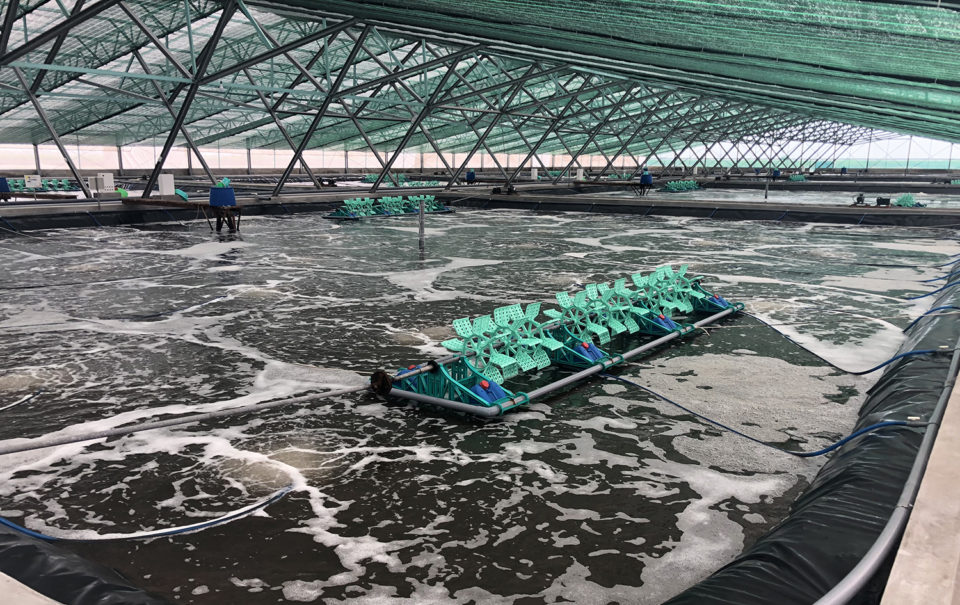
Viet-Uc Seafood Corporation is the largest producer of shrimp postlarvae (PL) in Vietnam, with an annual capacity to supply farms with more than 50 billion PLs from its multiple hatcheries. To diversify, Viet-Uc has recently begun to expand its operations to super-intensive indoor farming of Pacific white shrimp (Litopenaeus vannamei). To develop and optimize such production systems, Viet-Uc has partnered with the Commonwealth Scientific and Industrial Research Organisation (CSIRO).
CSIRO is Australia’s national science agency with an 85-year track record in developing and applying leading-edge science and technology across industrial sectors including agriculture and food, environment, manufacturing and materials, health and life science, and energy and minerals. With more than 5,500 staff working in Australia and internationally, CSIRO is among the top 10 applied research organizations in the world. The Livestock and Aquaculture Program has been delivering transformative technologies in Australia and globally for more than two decades through innovations in aquafeeds, animal health, production systems and breeding programs for major aquaculture species.
Since 2010, CSIRO has been collaborating closely with Viet-Uc to develop and validate systems for improving shrimp PL production as well as shrimp growth performance and robustness through health management and selective breeding. This collaboration has recently expanded to develop hatchery and genetic management systems for pangasius and, as will be discussed in more detail below, production systems for the super-intensive indoor grow-out of L. vannamei amenable to environmental conditions in Vietnam’s Mekong Delta.
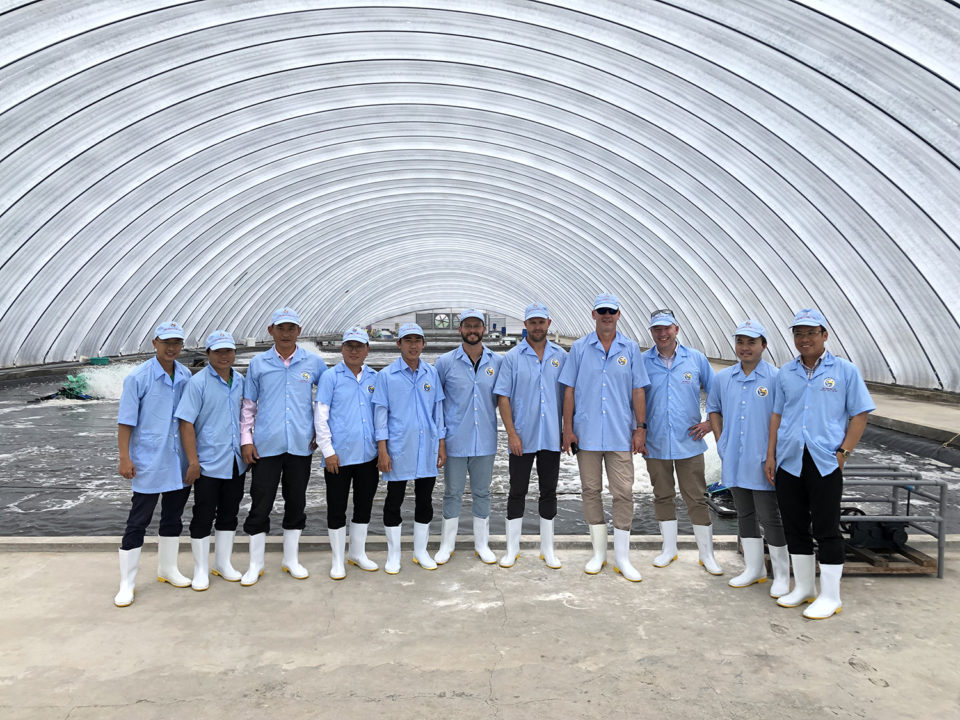
Rigorous commercial-scale experiments to develop and evaluate different production systems began in Bac Lieu Province in late 2017. These involved assessing various innovative solutions for optimizing grow-out survival and yields. The activities included assessing shrimp health and biosecurity systems; water additives to manage bioflocs and pathogens; sensor technologies to progressively monitor water quality parameters; data collation and management; software engineering, automation and decision support tools; and economic modelling. Another key to the success of the collaboration has been the training of Viet-Uc staff in managing and maintaining pond water qualities and bioflocs to within specified optimal parameters.
Commercial-scale experiments
To date, the project has completed five trials, each utilizing 20 to 24 lined, 500-square-meter grow-out ponds in two enclosed greenhouses at the super-intensive rearing farm at Bac Lieu. The trials ran from stocking to harvest (90 to 100 days of culture), with four to six replicate ponds used to assess each rearing system. Comprehensive monitoring systems were employed to identify factors constraining production outcomes. Through access to a dedicated onsite R&D laboratory and deploying state of the art sensor technologies, more than 25 different production-related parameters were routinely monitored.
These parameters included the various pond water quality parameters, microbial communities, shrimp survival and growth performance, health and color as well as weather conditions and the nature of waste produced from the ponds. To manage and interpret these large data sets, a customized, cloud-based data management system was developed and deployed. Not only did this data collection approach enable each rearing system to be comprehensively evaluated and compared, but it also provided a means of accurately assessing rearing system economics and for applying machine learning tools to refine them.
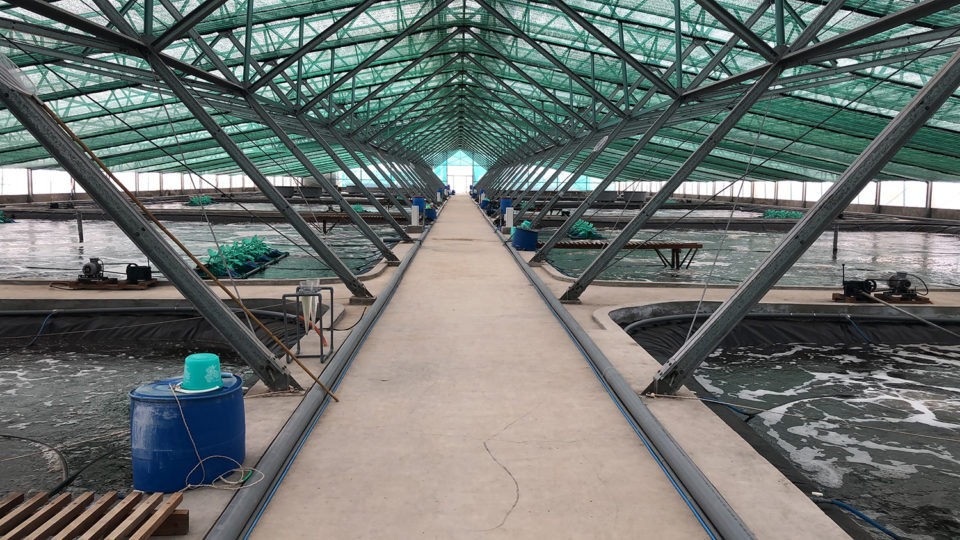
The assessment of various methods of establishing and maintaining a healthy biofloc was key to defining rearing systems amenable to Viet-Uc greenhouse infrastructure and weather conditions at Bac Lieu in the Mekong Delta. Iterative methods refinements to achieve this goal were made through investigating the impacts of various microbial maturation procedures, aeration systems, water supplements, feeding strategies and feed additives. The main outcomes derived from their deployment included more effective and efficient water use, reduced vibrio numbers in both the ponds and shrimp, reduced sludge production, reduced biosecurity risks and improved shrimp quality at harvest. Investigating the impacts of stocking density, partial harvest strategies and alternative vibrio control methods also contributed to optimizing a super-intensive rearing system.
Due to their importance to commercial shrimp grow-out, biosecurity and disease mitigation systems were also considered. The presence and loads of viruses and bacteria were thus monitored regularly to identify associations with growth performance and survival and whether different rearing systems were less impacted than others. Moreover, the project included a specific economic component to assess and compare rearing system production costs and profitability under a range of market conditions. Economic modelling was also extended to estimating potential gains in profitability that might be achieved through various system refinements, thus providing a tool for targeting R&D to those offering the greatest potential.
Furthermore, the project offered an opportunity to deploy novel sensor technologies and develop and test machine learning algorithms to assist in transitioning production to more automated systems. Such automation will be critical for future expansion of super-intensive shrimp production and in reducing the reliance on highly skilled technical staff.

A key requirement for the sustainability of farms is the ability to accurately predict shrimp growth and harvest yields in order to target markets that maximize profits. However, shrimp grow-out systems are complex and influenced directly and indirectly by many system design, management strategy, nutrition and health factors. Without a deeper understanding of these influences, production is often unpredictable. The commercial-scale data collection and evaluation systems, machine learning models, and the iterative refinement and assessment of farm-specific management protocols deployed in this project have advanced this deeper understanding, and therefore greatly improved our ability to reliably predict shrimp growth and production yields.
Perspectives
Executing R&D in commercial scale shrimp grow-out systems is challenging and requires a fine balance between meeting commercial imperatives while preserving scientific rigor. To meet this challenge, the collaborative project between Viet-Uc and CSIRO has focused on developing technologies to sustain profitable super-intensive shrimp farming in Vietnam. These technologies have involved taking a multi-factorial approach to how such super-intensive grow-out systems are designed and managed.

To date, five commercial-scale experiments have been completed, with diverse and comprehensive data being collected for 112 commercial ponds in conjunction with progressively improved rearing technologies and shrimp yields to more than 40 tons per hectare equivalent at higher than 85 percent survival rates and with feed conversion ratios of less than 1.3. While achieving such production metrics has been core to maximizing the rearing system profitability, data being collected on systems to minimize water use, control vibrio numbers and automate elements of the production system are expected to improve its long-term sustainability.
Industry-based research partnerships of the scale undertaken in this project, while important to the end-user, are also critical to the mission of CSIRO to develop, evaluate and deploy new technologies in the real world. Irrespective of where knowledge is acquired, it will be readily accessible from CSIRO to underpin the continued expansion of a profitable Australian shrimp farming industry.
CSIRO has a major strategic investment in developing the aquaculture sector locally and globally. This multi-factorial project is thus testament to the knowledge gains that can be made through collaborating directly with an industry partner with the infrastructure, technical support capabilities and desire to advance high-tech shrimp rearing systems.
The CSIRO team wishes to acknowledge and thank Viet-Uc for their ongoing support, dedication of commercial greenhouses to the project and the contribution from their enthusiastic staff who made the research possible.
Now that you've reached the end of the article ...
… please consider supporting GSA’s mission to advance responsible seafood practices through education, advocacy and third-party assurances. The Advocate aims to document the evolution of responsible seafood practices and share the expansive knowledge of our vast network of contributors.
By becoming a Global Seafood Alliance member, you’re ensuring that all of the pre-competitive work we do through member benefits, resources and events can continue. Individual membership costs just $50 a year.
Not a GSA member? Join us.
Authors
-
Stuart Arnold
Corresponding author
Commonwealth Scientific and Industrial Research Organisation (CSIRO)
Bribie Island Research Centre
144 North Street, Woorim, Qld. Australia -
Mauricio G.C. Emerenciano, Ph.D.
Commonwealth Scientific and Industrial Research Organisation (CSIRO)
Bribie Island Research Centre
144 North Street, Woorim, Qld. Australia -
Jeff A. Cowley, Ph.D.
Commonwealth Scientific and Industrial Research Organisation (CSIRO)
Queensland Bioscience Precinct
306 Carmody Road, St. Lucia, Qld. Australia -
Bryce Little
Commonwealth Scientific and Industrial Research Organisation (CSIRO)
Queensland Bioscience Precinct
306 Carmody Road, St. Lucia, Qld. Australia -
Ashfaqur Rahman, Ph.D.
Commonwealth Scientific and Industrial Research Organisation (CSIRO)
Sandy Bay Site
15 College Road, Sandy Bay, Tas. Australia -
Tim Perrin
Commonwealth Scientific and Industrial Research Organisation (CSIRO)
Bribie Island Research Centre
144 North Street, Woorim, Qld. Australia
Tagged With
Related Posts
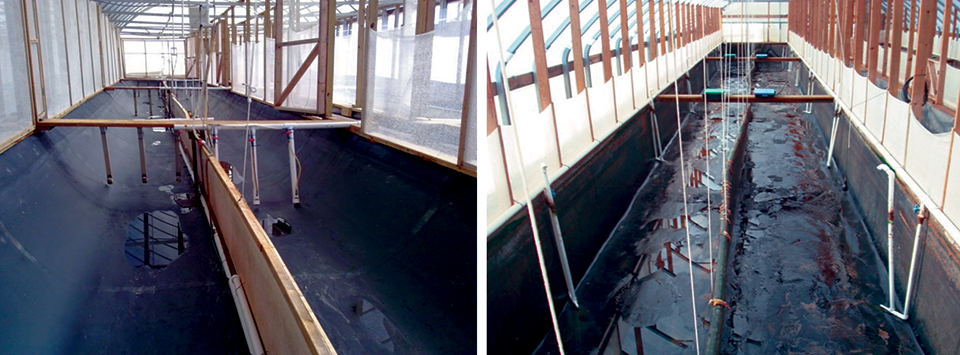
Responsibility
Advances in super-intensive, zero-exchange shrimp raceways
Research at the Texas AgriLife Research Mariculture Laboratory is investigating ways to improve the economic viability of super-intensive raceways for shrimp production.
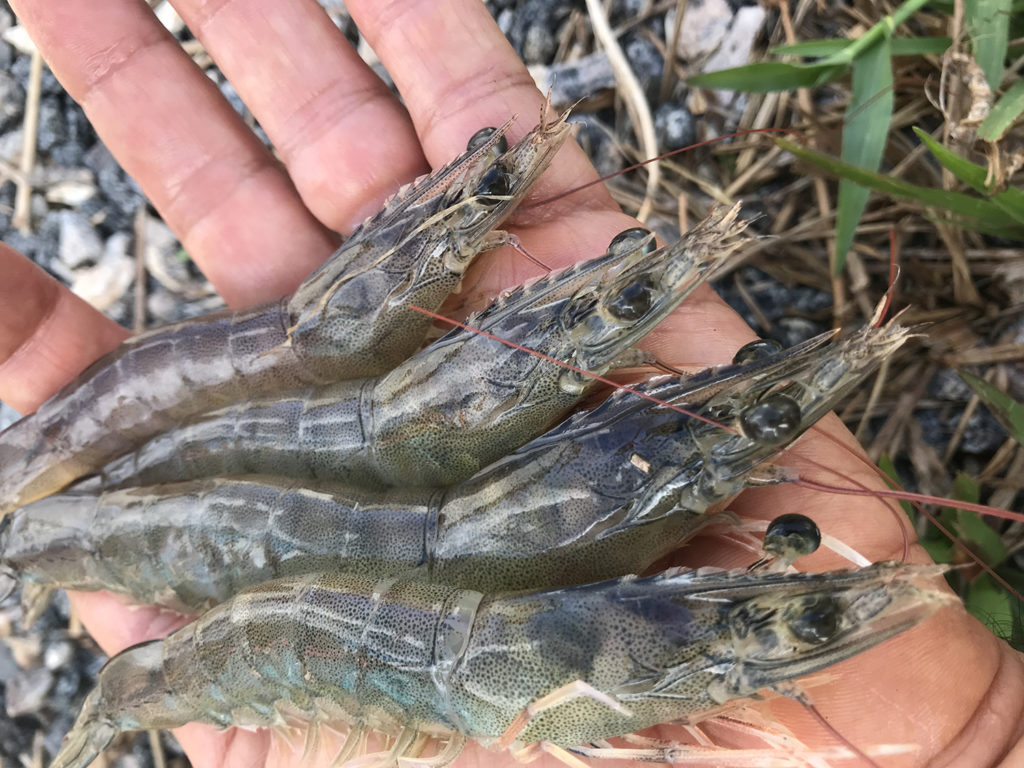
Health & Welfare
Culture of Pacific white shrimp juveniles in super-intensive conditions
Results of this study showed that L. vannamei juveniles can be cultured at high densities with adequate survival, growth and feeding efficiency, and with minimal water exchange or full water reuse through recirculation.
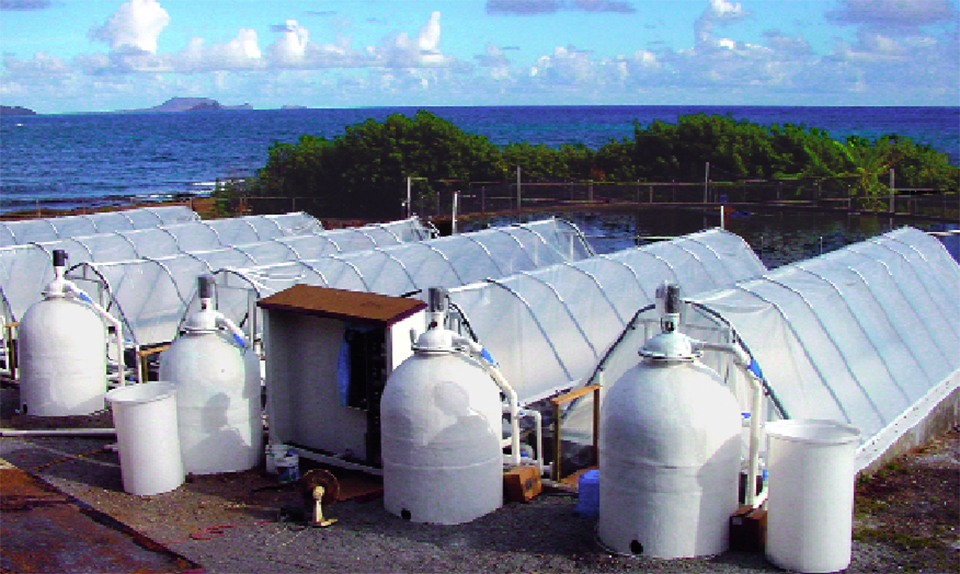
Health & Welfare
Shrimp behavior may affect culture performance at super-intensive stocking densities
Results from two studies at Oceanic Institute indicated that shrimp behavior may compromise growth at super-intensive stocking densities.

Health & Welfare
Stress-vibrio dynamics during high-density, zero-exchange production of white shrimp
Vibrio infections are an increasingly common problem in intensive shrimp culture. As evidenced by study results, weekly Vibrio monitoring can be a useful tool for predicting bacterial disease outbreaks.


